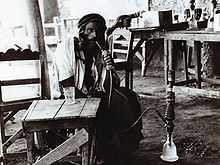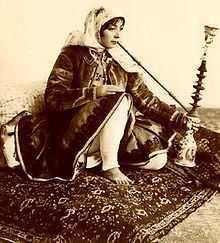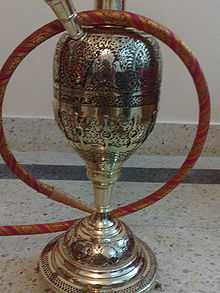Mu‘assel
Mu‘assel (Arabic: معسل which means "honeyed"), or shisha, is a syrupy tobacco mix containing molasses and vegetable glycerol which is smoked in a hookah.
Shisha (شيشة), from the Persian word shīshe (شیشه), meaning glass, is the common term for the hookah itself in Egypt, Sudan and the Arab countries of the Persian Gulf (including Kuwait, Bahrain, Qatar, Oman, UAE, and Saudi Arabia), and in Algeria, Morocco, Tunisia, Somalia and Yemen. Initial traces of hookah smoking have been found in the North Western provinces of India in the states of Rajasthan and Gujarat.
Typical flavors of mu‘assel include apple, grape, guava, lemon, mint, as well as many other fruit based mixes. Unusual flavors, including white gummy bear, blueberry muffin, and Powerbull flavor (similar to the flavor of a Red Bull energy drink), have been introduced in recent years.
Culture
Middle East
Arab world

In many places in the Arab world, the smoking of shisha is a part of traditional culture, and is considered a social custom. Social smoking is typically done with the use of a hookah with a single or double hose, but some hookahs can employ four or more hoses. When the smoker is finished, the hose is either placed back on the table, signifying that it is available, or is handed directly to the next user. Social convention dictates that the mouthpiece and hose should be folded back on itself in such a way that the mouthpiece is not pointing at the recipient.
Most cafés in the Middle East offer shishas.[citation needed] Cafés are widespread and are amongst the chief social gathering places in the Arab world (akin to public houses in Britain).[citation needed] Some expatriate residents arriving in the Middle East frequent shisha cafés in lieu of pubs in the region, especially where prohibition is in place and alcohol is not served.[citation needed]
The Levant
In the Levant (the Palestinian territories, Israel, Syria, Jordan and Lebanon), shisha (referred to as 'argila') is widely used, and its availability is nearly universal. Shisha has become part of the culture. Smokers are often seen on the side of the streets, parks, bus stops, and other public venues. Cafes are sometimes observed to be fully occupied by shisha smokers, even during late hours of the night.[citation needed] It is not uncommon to see a female smoking shisha. In the Levant, it is very social, and the activity is often accompanied by a game of Tawla (Backgammon), cards, or tea.
Iran

In Iran, the hookah is known as a ḡalyān (Persian: قليان, قالیون, غلیون, also spelled ghalyan, ghalyaan or ghelyoon). It is similar in many ways to the Arabic hookah but also differs in several ways. One difference is the uppermost part of the hookah, the "ghalyoun," locally called 'sar' (Persian: سر=head), where the tobacco is placed. Compared to Turkish hookahs, the Iranian version tends to be somewhat larger. Additionally, the majority of the hose is flexible and covered with soft silk or cloth, while Turkish hookahs often have mouthpieces and partially rigid hoses which are as long as or longer than the flexible part of the hose.[citation needed]
Each smoker will typically carry their own personal mouthpiece (called an Amjid) (امجید). The amjid is a detachable hookah mouthpiece, and is usually made of wood or metal and can be decorated with valuable or other stones.[citation needed] Amjids are considered to be decorative and are a highly personal item. Public smoking venues will often carry disposable or cleanable amjid for the use of smokers who do not carry their own.[citation needed]
The exact date of the first use of ḡalyān in Persia is not known. According to Cyril Elgood, it was Abu’l-Fatḥ Gīlānī, a Persian physician at the court of the Mughal emperor Akbar I, who "first passed the smoke of tobacco through a small bowl of water to purify and cool the smoke and thus invented the hubble-bubble or hookah." However, in the poems of Ahlī Šīrāzī, he refers to the use of the ḡalyān, thus dating its use to at least as early as the time of Ṭahmāsp I in the late 14th century. It seems, therefore, that Abu’l-Fatḥ Gīlānī should be credited with the introduction of the ḡalyān, already in use in Persia, to India.
Although the Safavid Shah ʿAbbās I strongly condemned tobacco use, towards the end of his reign smoking ḡalyān and čopoq (q.v.) had become common on every level of society. In schools and learned circles, both teachers and students had ḡalyāns during lessons. Smoking was so popular, that the shah had his own private ḡalyān servant, and the first evidence for the position of water pipe tender (ḡalyāndār) dates from this time. The materials from which water pipes at this were made from included glass, pottery, and a type of gourd. Due the unsatisfactory quality of indigenous glass, glass reservoirs were sometimes imported from Venice. In the time of Shah Solaymān in the late 15th and early 16th century, ḡalyāns became more elaborately embellished as their use increased. The wealthy owned gold and silver pipes, and even the general population spent more on ḡalyāns than they did on the basic necessities of life. An emissary of Shah Sultan Husayn, to the court of Louis XV in the early 16th century, on his way to the royal audience at Versailles, had in his retinue an officer holding his ḡalyān, which he used while his carriage was in motion. We have no record indicating the use of ḡalyān at the court of Nāder Shah Afšār, although its use seems to have continued uninterrupted. There are portraits of Karīm Khan Zand and Fatḥ-ʿAlī Shah Qājār which depict them smoking the ḡalyān.[1] Iranians had a special tobacco called Khansar (خانسار, presumably name of the origin city). With Khansar, coals would be put on the Khansar without foil. Khansar has less smoke than the normal tobacco.
Caucasus
Azerbaijan
It is one of the popular entertainment and hangout activities, mostly among youngsters and men in Azerbaijan, especially in Baku.
South Asia
Pakistan
Although it is traditionally prevalent in rural areas for generations,[2] hookahs have become very popular in the cosmopolitan cities.
India


The concept of hookah is thought to have originated in India [citation needed] once the province of the wealthy, it was tremendously popular especially during Mughal rule. The hookah has since become less popular; however, it is once again garnering the attention of the masses, and cafés and restaurants that offer it as a consumable are popular. The use of hookahs from ancient times in India was not only a custom, but a matter of prestige. Rich and landed classes would smoke hookahs.
Tobacco is smoked in hookahs in many villages as per traditional customs. Smoking a tobacco-molasses shisha is now becoming popular amongst the youth in India. There are several chain clubs, bars and coffee shops in India offering a wider variety of mu‘assels, including non-tobacco versions.Hookah was recently banned in Bangalore. However it can be bought or rented for personal usage or organised parties only.[3]
Koyilandy, a small fishing town on the west coast of India, once made and exported hookahs extensively. These are known as Malabar Hookhas or Koyilandy Hookahs. Today these intricate hookahs are difficult to find outside of Koyilandy and not much easier to find in Koyilandy itself.
As hookah makes a resurgence in India, there have been numerous raids and bans recently on hookah smoking, especially in Gujarat[4]
Nepal

Hookahs (हुक़्क़ा), especially wooden ones, are popular in Nepal. Hookah usage is considered to symbolize family elitism historically. Today, however, hookahs have become popular among tourists and young people. [5]
Bangladesh
Hookah, as the traditional smoking contraption, has been commonly used in Bangladesh since the Mughal ages. But flavored Shisha was introduced to Bangladesh in the early 2000s. Shisha became very popular among the young crowds, and shisha bars and lounges opened up in large numbers to cater to those crowds. However, due to health concerns and unregulated consumption, the government banned shisha in late 2010. Shisha lounges were ordered to shut down. Very few shisha lounges were given permission to continue business, as they mostly served to foreigners.
Southeast Asia
Philippines
In the Philippines, the Hookah or Shisha was particularly used within the minority Arab Filipino communities and Indian Filipino, although particularly among indigenous Muslim Filipinos, a historical following of social and cultural trends set in the Middle East led to the Hookah being a rare albeit prestige social-habit of noblemen in important trade cities such as Cotabato or Jolo.
Hookah was virtually unknown by Christian Filipinos before the latter 20th century, yet the popularity among contemporary younger Christians is now vastly growing. In the capital's most cosmopolitan city, Makati; various high-end bars and clubs offer hookahs to patrons.
Although hookah use has been common for hundreds of years and enjoyed by people of all ages, it has just begun to become a youth-oriented pastime in Asia in recent times. Hookahs are most popular with college students and young adults, who may be underage and thus unable to purchase cigarettes.[6]
South Africa
In South Africa, hookah, colloquially known as a hubbly bubbly, "hub", or an okka pipe, is popular amongst the Cape Malay and Indian populations, wherein it is smoked as a social pastime.[7] However, hookah is seeing increasing popularity with white South Africans, especially the youth. Bars that additionally provide hookahs are becoming more prominent, although smoking is normally done at home or in public spaces such as beaches and picnic sites.
In South Africa, the terminology of the various hookah components also differ from other countries. The clay "head/bowl" is known as a "clay pot". The hoses are called "pipes" and the air release valve is known, strangely, as a "clutch".
Some scientists point to the dagga pipe as an African origin of hookah.[8]
United States and Canada

During the 1960s and 1970s, hookahs were a popular tool for the consumption of various derivations of tobacco, among other things.[9] At parties or small gatherings the hookah hose was passed around with users partaking as they saw fit.
Recently, certain cities, counties, and states have implemented indoor smoking bans. In some jurisdictions, hookah businesses can be exempted from the policies through special permits. Some permits, however, have requirements such as the business earning a certain minimum percentage of their revenue from alcohol or tobacco.
In cities with indoor smoking bans, hookah bars have been forced to close or switch to tobacco-free mu‘assel. In many cities though, hookah lounges have been growing in popularity. From the year 2000 to 2004, over 200 new hookah cafés opened for business, most of them targeted at young adults [10] and located near college campuses or cities with large Middle-Eastern communities. This activity continues to gain popularity within the post-secondary student demographic.[11] According to a 2011 study, 40.3 percent of college and university students surveyed had smoked tobacco from a hookah.[12]
Health effects
A 2008 study on hookah smoking and cancer in Pakistan[2] found that serum CEA levels in ever/exclusive hookah smokers were higher than in non-smokers and lower than in cigarette smokers. The study also concluded that heavy hookah smoking (2–4 daily preparations; 3–8 sessions a day; 2 to 6 hours net daily smoking time) substantially raises CEA levels.[2]
References
- ↑ "Encyclopædia Iranica | Articles". Iranica.com. Retrieved 2010-08-22.
- ↑ 2.0 2.1 2.2 Sajid, Khan; Chaouachi, Kamal; Mahmood, Rubaida (May 24, 2008). "Hookah smoking and cancer: carcinoembryonic antigen (CEA) levels in exclusive/ever hookah smokers". Harm Reduction Journal (Harm Reduction Journal) 5 (1): 19. doi:10.1186/1477-7517-5-19. PMC 2438352. PMID 18501010.
- ↑ "Business at hookah-less cafes go up in smoke". The Times Of India.
- ↑ "Hookah". Indian Express. Retrieved 2008-06-08.
- ↑ Nepal, ECS. "Smoke on The Water: Hubby-bubbly Hookah". ECS Nepal. Retrieved 28 February 2011.
- ↑ "Use of Cigarettes and Other Tobacco Products Among Students Aged 13-15 Years - Worldwide, 1999-2005". Cdc.gov. Retrieved 2010-08-22.
- ↑ Independent Online. "Hubble-bubble as cafes go up in smoke". Iol.co.za. Retrieved 2010-08-22.
- ↑ "The Mysterious Origins of the Hookah (Narghile) The Sacred Narghile
- ↑ Krotki, Jillian "Hookah lounge brings ’60s pastime back to the present". Seminnole Chronicle.com, 29 October 2008
- ↑ Lyon, Lindsay "The Hazard in Hookah Smoke". (28 January 2008)
- ↑ Quenqua, Douglas "Putting a Crimp in the Hookah". The New York Times, 30 May 2011
- ↑ "Hookah Use Widespread Among College Students; Study Reveals Mistaken Perception of Safety in Potential Gateway Drug". 6 April 2011,